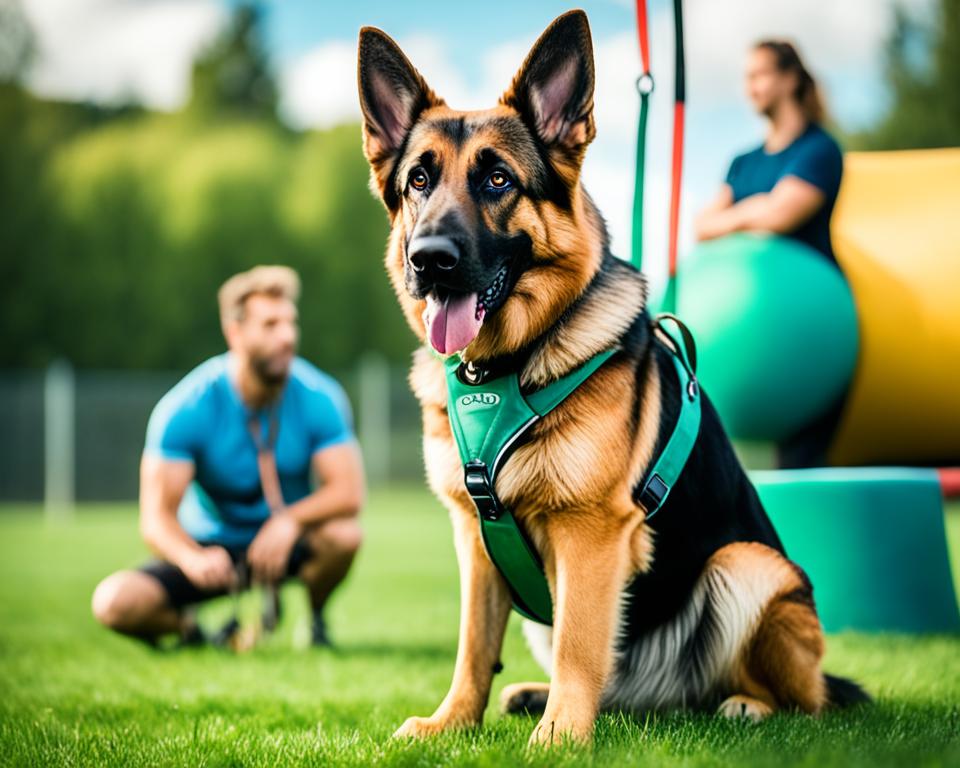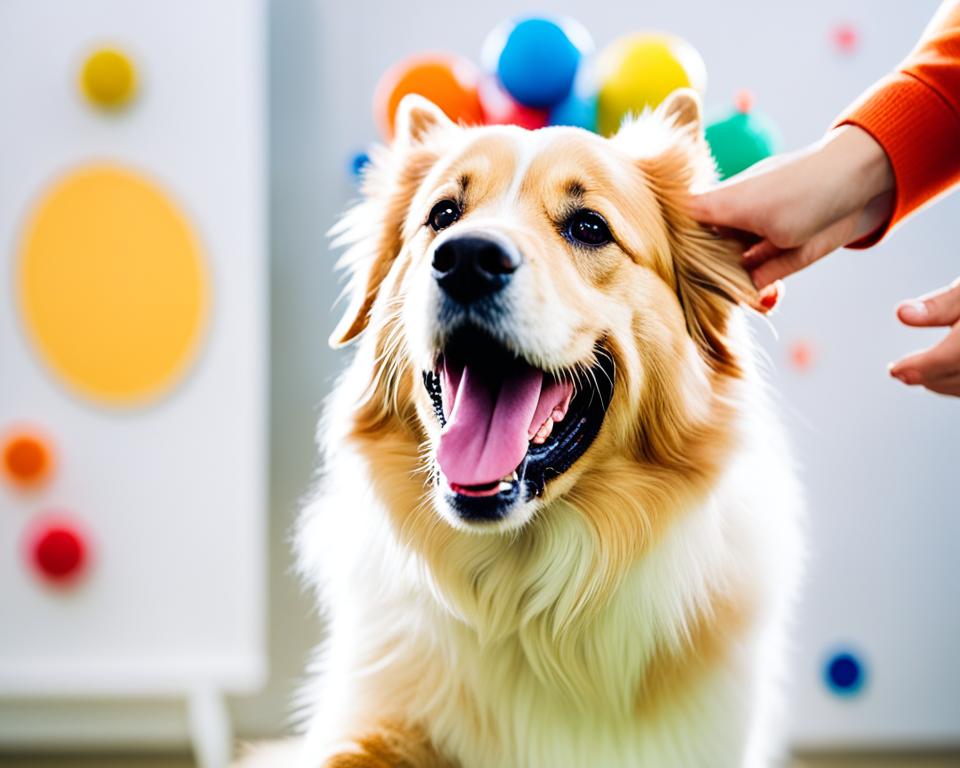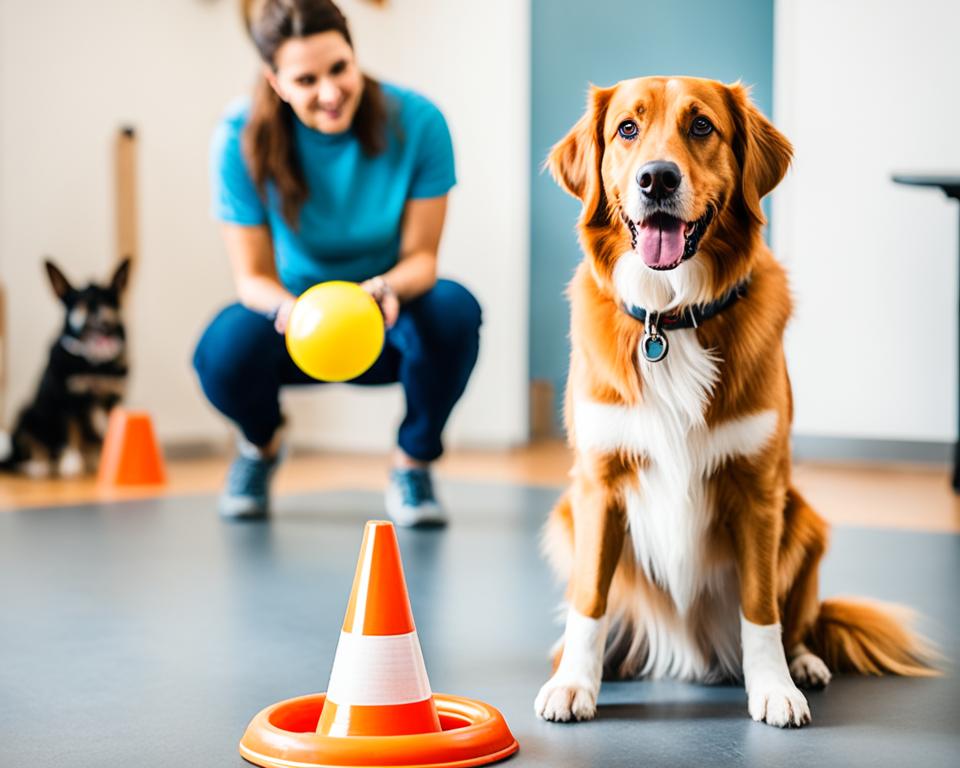Dog training is a rewarding journey for pets and their owners. It’s not just about teaching commands. It’s a way to build a strong bond with your furry friend. Understanding canine behavior and using positive reinforcement is key.
When I started training my dog, I found short, regular sessions work best. Puppies can focus for about 15 minutes, while adult dogs may handle up to 30 minutes. I aim for multiple brief training periods throughout the day. This keeps my dog engaged and eager to learn.
Dog obedience is just one part of training. I’ve also explored behavior training to address specific issues and even agility training for fun exercise. No matter the focus, patience and consistency are crucial. Using treats and praise to reward good behavior has led to amazing improvements in my dog’s obedience and demeanor.
Establishing a Strong Foundation for Dog Training
Building a solid base for dog training is key for success. It’s important to know your dog’s unique traits and start with basic obedience. This is the first step in your journey.
Understanding Your Dog’s Breed and Temperament
Every dog is unique, and training should match their breed and personality. I always learn about a dog’s breed and personality. This helps me tailor the training for better results.
The Importance of Patience in Training
Patience is key in training dogs. Dogs need time to understand new things. Over 20 years, I’ve seen that patience and gentle guidance work best. Remember, building a well-trained dog takes time!
Starting with Basic Commands
Basic obedience is the base of all training. I start with simple commands like ‘sit,’ ‘stay,’ ‘come,’ and ‘heel.’ These commands help you and your dog understand each other. Aim for your dog to follow these commands in 2 seconds for quick responses.
“The three key chapters of the Doggy Dictionary focus on timing and observation, markers, and commands as essential elements in establishing a strong foundation for dog training and effective communication.”
To help your dog learn, use markers like clickers or verbal cues. These give clear feedback, which makes your dog’s brain release dopamine. This feedback loop helps your dog repeat good behaviors, making them last.
| Training Program | Cost | Duration | Expiry |
|---|---|---|---|
| Puppy FUNdamentals | $195 | 6 weeks | 5 weeks (3-hour program) |
| Beginning FUNdamentals | $195 | 6 weeks | 8 weeks (5-hour program) |
| Continued FUNdamentals | $195 | 6 weeks | 12 weeks (7-hour program) |
Practice is key. Working on these basics in different places helps your dog learn to apply what they know. This sets a strong base for more training.
Mastering Essential Commands for Safety and Obedience
Dog obedience training is key for a well-behaved and safe pet. Basic commands are the base of this training. They make sure your dog listens in many situations.
First, teach safety commands like ‘sit’. It’s simple for dogs and helps with more complex commands later. ‘Stay’ and ‘come’ are also vital for safety in risky situations.

| Command | Purpose | Benefits |
|---|---|---|
| Sit | Basic control | Calms dog, prevents jumping |
| Stay | Impulse control | Keeps dog in place, enhances safety |
| Come | Recall | Ensures dog returns when called, crucial for safety |
| Heel | Leash walking | Prevents pulling, improves walk experience |
| Down | Relaxation | Calms dog in various situations |
Consistency is crucial in dog training. Practice these commands often in different places. This makes sure your dog listens well. Patience and positive rewards make training fun and successful for you and your dog.
The Power of Positive Reinforcement in Dog Training
Positive reinforcement changes dog training for the better. I’ve seen how it turns stubborn pups into eager learners. By rewarding good behavior, we get our furry friends to do it again.
Finding the Right Rewards for Your Dog
Every dog is different. Some love treats, while others prefer toys or praise. I start by finding out what motivates my dog. This makes training more effective and fun for us both.

Timing and Consistency in Reward-Based Training
Timing is key in clicker training. I reward my dog right after they do the right thing. This helps them understand the reward better. Being consistent is also important. I use the same cues and rewards every time to avoid confusion.
Balancing Treats and Verbal Praise
Treats are great, but I don’t use them only. I also use verbal praise and affection. This mix keeps training exciting and strengthens our bond.
| Training Method | Effectiveness | Bond Strength |
|---|---|---|
| Positive Reinforcement | High | Strong |
| Aversive Methods | Low | Weak |
Studies show positive reinforcement makes dogs more likely to do what we want. It also makes them more motivated to learn. Focusing on rewards instead of punishment creates a positive learning space that my dog enjoys.
Creating an Effective Training Schedule
Consistent training is key to raising a well-behaved pup. A dog training schedule helps with routine and good habits. Short training sessions keep your furry friend engaged and eager to learn.
Puppies need 5-10 minute sessions once or twice a day. Adult dogs can do up to 30 minutes, but break it into shorter bits. Remember, quality is more important than how long you train.

| Day | Morning Session | Evening Session |
|---|---|---|
| Monday | Basic obedience (10 min) | Leash training (15 min) |
| Tuesday | Trick training (10 min) | Socialization (20 min) |
| Wednesday | Recall practice (15 min) | Basic obedience (10 min) |
| Thursday | Agility exercises (20 min) | Trick training (10 min) |
| Friday | Basic obedience (10 min) | Leash training (15 min) |
| Saturday | Trick training (15 min) | Socialization (30 min) |
| Sunday | Recall practice (15 min) | Agility exercises (20 min) |
Follow this schedule, but adjust as needed for your dog’s progress and energy. The main thing is to keep training short and consistent. This makes training fun and effective, helping you and your pup succeed.
Advanced Training Techniques for a Well-Rounded Canine
Advanced dog training takes your furry friend’s skills to the next level. Once basic commands are learned, it’s time for more complex tasks. Let’s look at some exciting techniques to keep your dog’s mind sharp and body fit.
Teaching Complex Tricks and Commands
After learning sit and stay, I teach dogs to retrieve items or respond to hand signals. These skills are impressive and keep your dog’s mind busy. I use a clicker to mark good behavior, which works well in training.
Incorporating Agility Training
Agility training is great for bonding with your dog and boosting their fitness. I create obstacle courses with jumps, tunnels, and weave poles in my yard. This training helps with coordination and confidence in dogs of all sizes.
| Agility Equipment | Benefits |
|---|---|
| Jumps | Improves leg strength and coordination |
| Tunnels | Enhances spatial awareness |
| Weave Poles | Boosts agility and focus |
| A-frame | Develops balance and body control |
Problem-Solving Specific Behavior Issues
Behavior modification is key in advanced training. I use positive reinforcement to fix issues like too much barking or separation anxiety. For example, I teach the “quiet” command and give rewards for calmness. Consistency is important in solving these problems.
By using these advanced dog training methods, you’ll have a well-rounded canine. Tricks, agility training, and behavior modification will make your bond stronger. Your dog will be happier and more obedient.
Socialization and Leash Training for a Well-Behaved Dog
Puppy socialization and leash training are important for a well-behaved dog. I’ve learned that early exposure to different places, people, and animals helps puppies feel confident. This early socialization stops bad behavior and fears later.
Leash training is key for safe walks. I start with short, positive walks, rewarding my dog for walking nicely on a leash. If my dog pulls, I stop and wait for them to come back before we move on. This teaches them to walk nicely on a leash.
| Aspect | Benefit | Impact |
|---|---|---|
| Safety | Reduced accidents | Significant decrease in traffic-related incidents |
| Social Interaction | Fewer unintentional harm incidents | Lower rate of jumping or startling others |
| Behavior Improvement | Reduced boredom-related behaviors | Statistically significant improvement in attentiveness |
Using a 6-foot leash helps control my dog during training. It’s key to handle issues like pulling or sudden aggression with patience and consistency. Positive reinforcement makes a dog happy and well-socialized.
Overcoming Common Training Challenges and Seeking Professional Help
Dog training challenges can be tough, but they’re not impossible to beat. Leash pulling is a big issue, often causing leash reactivity. This makes walks hard for you and your dog.
Gradually exposing dogs to new places and things can really help. It makes their walks better.
When dealing with chewing, biting, or too much barking, being consistent is crucial. Setting clear rules and using positive rewards helps. This reduces stress and betters behavior.
For house training, rewarding your dog with treats and praise for going potty works well. Remember, it’s okay if you face setbacks. Always set achievable goals based on your dog’s pace.
If you’re having trouble with your dog’s behavior, get help from a pro. They can give you tailored advice for your dog’s issues, especially if they’re scared or reactive. In Portland, there are many skilled trainers ready to help. Even though it takes time and money, the long-term benefits of professional training are worth it. It helps make your dog happier and better behaved.

